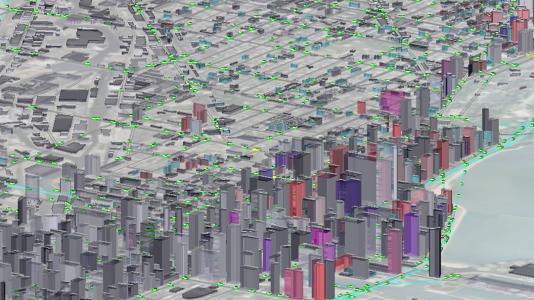
Cities are dogged by similar transportation and energy challenges, from congestion and emissions to inefficiencies in public transit, emerging connected and automated vehicle technologies, and more. To address these complex challenges, and leverage the benefits of new infrastructure, communication and vehicle technologies, city planners and developers are increasingly turning to high fidelity computer modeling and simulation.
With models, policymakers can visualize and analyze many of the factors affecting mobility and transportation, like traffic patterns, congestion, parking requirements, and energy consumption. They can also predict how changes, like the implementation of a new transportation infrastructure project, vehicle technology, or ride share service will affect people’s mobility and energy use. Such insights can accelerate and improve decision-making for urban developers, emergency planners, and various other stakeholders who strive to improve mobility access and convenience for all of us.
While models offer many benefits, developing and running them takes considerable time and resources. They are also traditionally nontransferable, meaning that a model that’s developed for one city often can’t be easily applied to another. But researchers at the U.S. Department of Energy’s Argonne National Laboratory are working toward a transformational solution.
Argonne researchers are creating computational tools and processes that can deliver a turnkey solution to analyzing common mobility and energy challenges that cities face. Designed with usability and scalability in mind, these tools will enable faster and easier analysis than ever thought possible.
“The key is to improve model usability and reusability. To improve usability, we focus on developing novel processes to accelerate the simulation time from days to hours. To improve reusability, we create generic models that can be applied in multiple cities and within multiple scenarios. And, having a standard workflow is fundamental for a sustainable process,” said Aymeric Rousseau, System Modeling and Control Group Manager at Argonne.
Driving from Chicago to Detroit
Rousseau and his colleagues have a long record of success in using computational tools to better understand how U.S. cities and their surrounding suburbs function. For example, in projects evaluating evacuation processes in Chicago and energy use changes due to vehicle automation, researchers modeled over 20 counties in and around the city, including more than 10 million people and over 30 million trips per day. But it’s within the city of Detroit that researchers first demonstrated their ability to develop models by using existing processes from other cities.
In this project, Rousseau and Principal Computational Transportation Engineer Joshua Auld analyzed future changes in Detroit’s mobility and energy use by evaluating scenarios of population and land-use shifts proposed by Detroit Future City and the Southeast Michigan Council of Governments.
To perform these analyses, the team combined two of Argonne’s innovative modeling platforms: POLARIS and Autonomie. POLARIS simulates mobility and traffic flow by predicting the individual behavior of “agents,” which represent people, households, organizations, etc. For Detroit, it simulated each of the 4 million individual agents within, and the 17 million trips they made per day.
Complementing the POLARIS analyses, Autonomie examined how much energy each individual vehicle consumes. When combined with topography and speed estimates, Autonomie modeled the entire energy use of Detroit’s transportation system, for both current-day and future-year vehicle technologies (i.e., conventional cars or hybrids or electric vehicles) and populations.
“What’s unique about our work in Detroit is that we were able to demonstrate the transferability of our workflow and models. We can now take the processes we’ve developed and use them in other applications, in other cities, and further grow and optimize our processes from here,” Auld said.
Fast and Furious Analysis
The processes developed by Rousseau and Auld thus far cut down on the time needed for high fidelity computational analysis, while at the same time allowing for the simulation of millions of individual agents. By comparison, other approaches commonly sample a small subset of the population, due to computational time limitations.
“It can typically take days for people to run analyses using traditional methods, but with our computational analysis it takes hours. These advances offer a more turnkey ready resource for policymakers looking to plan for the future,” Rousseau said. “We’re proud to be developing research tools that can contribute to smarter solutions for American mobility that deliver improvements in our quality of life.”
The development of POLARIS was funded by the U.S. Department of Transportation and the Federal Highway Administration.
The development of Autonomie was funded by the U.S. Department of Energy’s Office of Energy Efficiency and Renewable Energy, Vehicle Technologies Office. The Department of Energy continues to support the integration of POLARIS and Autonomie and the continued development of POLARIS.
